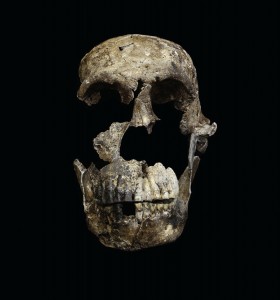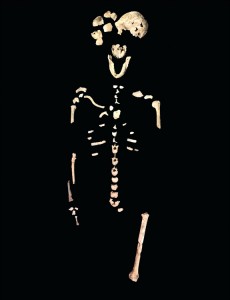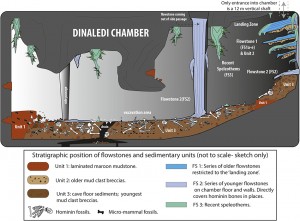Naledi of the Rising Star
Thursday, June 1st, 2017June 1, 2017
Recent studies show that Homo naledi, an intriguing species of prehistoric humans, may have lived far more recently than previously believed. Paleoanthropologists (scientists who study human evolution) say that H. naledi, a primitive hominin (human ancestor) known from a collection of fossils discovered at the Rising Star cave system in South Africa, may have lived at the same time and in the same region as more advanced prehistoric humans. Other new evidence shows that H. naledi may have had remarkably modern cultural practices that are seen among living people today, including funeral customs.

This nearly complete adult Homo naledi skull was found in the Rising Star cave system in South Africa. Credit: © John Hawks, Wits University
Between 2013 and 2017, an international team of excavators recovered more than 1,500 fossilized bones from the Rising Star cave site about 30 miles (48 kilometers) northwest of Johannesburg. The fossils were discovered in two deep cave chambers called Dinaledi and Lesedi (meaning stars and light in the local Lesotho language). Scientists quickly recognized the fossils as belonging to a previously unknown hominin that they named H. naledi. The anatomy of H. naledi shows a brain case less than half the size of that of modern people. The anatomy of the hands and shoulders suggests H. naledi was adept at climbing trees. These primitive characteristics suggest H. naledi lived perhaps 2 million years ago, when the first humanlike creatures appeared in Africa.

The fossilized remains of this Homo naledi skeleton suggest a stature of about 5 feet tall (150 centimeters). Credit: © John Hawks, Wits University
This May, researchers led by geoscientist Paul Dirks of James Cook University in Australia determined the age of the Rising Star cave fossils and their surrounding sediments using a combination of dating techniques. The fossils and sediments were determined to be between about 335,00 and 236,000 years old. These dates are much more recent than most scientists thought possible for such a primitive-appearing hominin.
The scientists who examined the fossils also suggest that the hominins called H. naledi may have intentionally placed their dead at the site—a remarkable behavior not seen among most ancient human ancestors. They point out that the Dinaledi and Lesedi chambers are deep underground and cannot be easily reached from the surface. By studying the sediments in the chambers, scientists could see that the bones had not been washed into the site by floodwaters.
Through studies of the fossil record, scientists know that other hominins lived in Africa and elsewhere at the same time as H. naledi. These archaic humans include Homo heidelbergensis, who were physically different from modern people, yet far more advanced than H. naledi, with larger brains and sophisticated stone tool cultures. However, evidence of intentional burial or other funeral customs is completely unknown from the fossil record of these early hominins.
Scientists contend the discovery of more H. naledi bones in another difficult-to-access part of the cave system supports their hypothesis that these hominins deliberately placed their dead in these locales. Such mortuary behavior was thought to be exclusive to larger-brained Homo sapiens.
In 2017, more H. naledi fossils were excavated from the recently found Lesedi chamber of the Rising Star cave system. The Lesedi chamber has no direct connection to the Dinaledi chamber. The fossil remains of at least three individuals were recovered from Lesedi. The remains include the well-preserved skeleton of a child and an adult male with a nearly complete skull.
Scientists are puzzled by how the remains came to be in the Lesedi part of the cave. The chamber contains almost no other ancient remains. Many of the hominin fossils were discovered undamaged with no evidence of being bitten or chewed by predators. Here too there was no evidence that the bones were washed into the site by floodwaters. If the remains were not intentionally placed there, as the evidence suggests, another possibility is that the hominins somehow became trapped in the cave and died together. If the hominins known as H. naledi did indeed practice funeral customs, they would be the earliest known hominins to do so.



